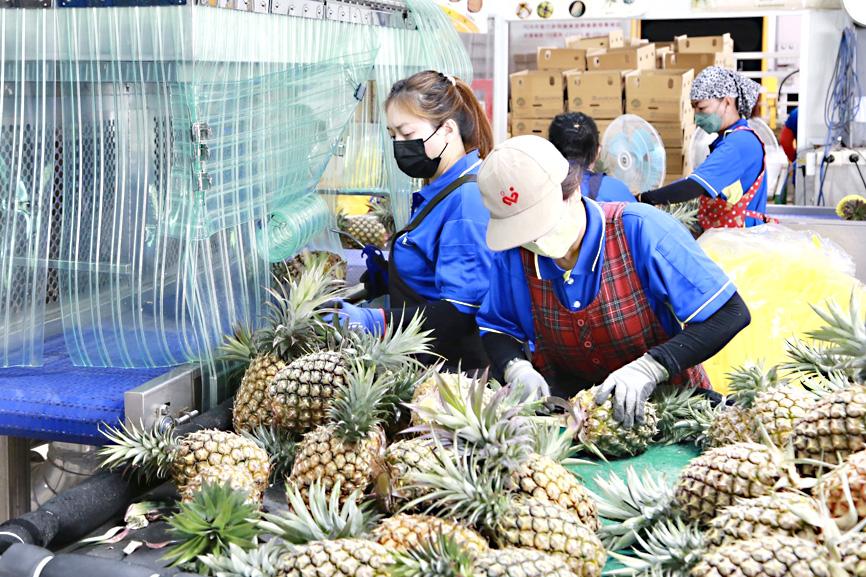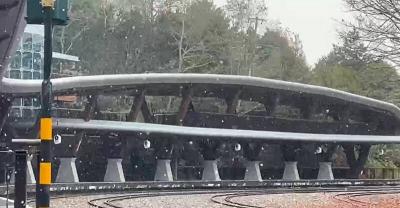Pineapple exports have so far this year risen more than 12 percent, showing that the industry has cast off reliance on the Chinese market following Beijing’s ban on imports of the fruit from Taiwan last year.
Exports of pineapples totaled 9,805 tonnes in the first three months, up 12.2 percent year-on-year, Council of Agriculture data showed.
This was despite the ban China imposed in March last year on imports of the tropical fruit from Taiwan, citing unspecified pests.

Photo: CNA
Council Minister Chen Chi-chung (陳吉仲) spoke alongside Tainan Mayor Huang Wei-che (黃偉哲) at a news conference in the city yesterday touting pineapple exports to Japan.
Ceremoniously closing a truck ready to ship nearly 14 tonnes of pineapples overseas, the officials thanked Japanese for their enthusiastic support of Taiwanese agriculture.
Even after China banned imports without warning, Taiwan’s growers found other markets with help from the council and the Agriculture and Food Agency, Huang said.
Although this year has seen a smaller export volume than during the same period last year, the quality is better, meaning that selling prices can be higher, he said.
The council last year acted quickly to promote local consumption and exports of pineapples, as well as the creation of value-added products, ensuring that growers did not feel the effects of China’s ban, the Tainan Agriculture Bureau said in a statement yesterday.
Taiwan last year exported a total of 28,000 tonnes of pineapples, council data showed.
Excluding exports to China, those bound for other markets increased by 533 percent from 2020.
Japan received nearly 18,000 tonnes, up 726 percent.
The council this year is still promoting pineapples to new markets, with the goal of increasing exports to 30,000 tonnes.
The council appears on track to achieve its goal, even without the Chinese market, the bureau said.
Successfully capturing the confidence of Japanese consumers also proves the quality of Taiwanese produce, as Japan imposes strict import quality and safety controls, the bureau added.

US President Donald Trump said "it’s up to" Chinese President Xi Jinping (習近平) what China does on Taiwan, but that he would be "very unhappy" with a change in the "status quo," the New York Times said in an interview published yesterday. Xi "considers it to be a part of China, and that’s up to him what he’s going to be doing," Trump told the newspaper on Wednesday. "But I’ve expressed to him that I would be very unhappy if he did that, and I don’t think he’ll do that," he added. "I hope he doesn’t do that." Trump made the comments in

NOT AN OPENING: Trump’s violation of international law does not affect China’s consideration in attacking Taiwan; Beijing lacks capability, not precedent, an official said Taiwanese officials see the US’ capture of the president of Venezuela as a powerful deterrent to Beijing’s aggression and a timely reminder of the US’ ability to defeat militaries equipped with Chinese-made weapons. The strikes that toppled Venezuelan President Nicolas Maduro signaled to authoritarian leaders, including Chinese President Xi Jinping (習近平), US President Donald Trump’s willingness to use military might for international affairs core to US interests, one senior official in Taipei’s security circle said. That reassured Taiwan, the person said. Taipei has also dismissed the idea that Trump’s apparent violation of international law could embolden Beijing, said the official, who was not

A cold surge advisory was today issued for 18 cities and counties across Taiwan, with temperatures of below 10°C forecast during the day and into tonight, the Central Weather Administration (CWA) said. New Taipei City, Taipei, Taoyuan and Hsinchu, Miaoli and Yilan counties are expected to experience sustained temperatures of 10°C or lower, the CWA said. Temperatures are likely to temporarily drop below 10°C in most other areas, except Taitung, Pingtung, Penghu and Lienchiang (Matsu) counties, CWA data showed. The cold weather is being caused by a strong continental cold air mass, combined with radiative cooling, a process in which heat escapes from

Snow this morning fell on Alishan for the first time in seven years, as a strong continental cold air mass sent temperatures plunging across Taiwan, the Central Weather Administration (CWA) said. The Alishan weather station, located at an elevation of about 2,200m in central Taiwan, recorded snowfall from 8:55am to 9:15am, when the temperature dropped to about 1°C, the CWA said. With increased moisture and low temperatures in the high-altitude Alishan area, the conditions were favorable for snow, CWA forecaster Tsai Yi-chi (蔡伊其) said. The last time snow fell at the Alishan weather station was on Jan. 10, 2018, while graupel fell there